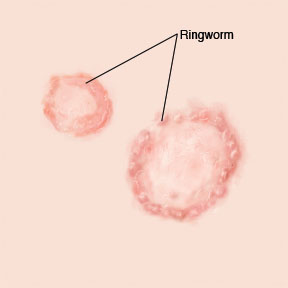Ringworm is a fungal infection of the skin. Despite the name, a worm or bug doesn't cause it. It's caused by a fungus that infects the outer layers of the skin.
The medical term for ringworm is tinea. It can affect most parts of your body. But it seems to be more often seen in moist parts of the body and around hair. It can be on almost any part of your body, including:
-
Arms, hands, legs, chest, feet, and back.
-
Scalp.
-
Beard.
-
Groin.
-
Between the toes.
The name of the type of ringworm is based on its location on the body. For example:
-
Tinea capitis (scalp)
-
Tinea cruris (groin, inner thigh, or buttocks), commonly called jock itch
-
Tinea corporis (other parts of the body, such as arms or legs)
-
Tinea pedis (feet), commonly called athlete’s foot
-
Tinea faciei (face)
-
Tinea manuum (hand)
Causes
Ringworm is common all over the world, including in the United States. It can take less than 1 week and up to 2 weeks to develop the infection after being exposed. So you may not figure out the exact cause.
It's spread through direct skin-to-skin contact with:
-
An infected person or animal.
-
Infected soil.
-
Infected objects, such as towels, clothing, combs, hair brushes, hairbands, and barrettes.
-
Surfaces, such as locker rooms and public showers.
Symptoms
Symptoms often appear within 4 to 14 days after the skin comes in contact with the fungus that causes ringworm. At first you might not notice ringworm. Or you may just see a small, red, often raised itchy spot or pimple. Sometimes there may only be one spot. At other times there may be several. Ringworm can look slightly different on different parts of the body. But a few things are almost always seen:
-
Irregular, round, oval, or ring-shaped. This is why it's called ringworm.
-
Clearer or lighter color at the center, since it spreads from the center of the spot outward
-
Red or inflamed look
-
Raised
-
Itchy
-
Scaly, dry, or flaky
-
Hair loss at the site of the rash
Home care
Follow these tips to help care for yourself at home:
-
Leave it alone. Don't scratch at the rash or pick it. This can increase the chance of infection and scarring.
-
Take medicine as prescribed. If you were prescribed a cream, apply it exactly as directed. Make sure to put the cream on the rash and on the skin 1 to 2 inches around it. Oral medicines may be needed, particularly for ringworm on the scalp. Take it as directed and until your health care provider says to stop. Antifungal shampoos may also be needed for scalp ringworm.
-
Look for ringworm creams that are available without a prescription (over-the-counter). Follow the directions on the package label. Steroid creams are not recommended to treat ringworm. They can make it worse. If over-the-counter medicines are not working, tell your provider.
-
Keep it from spreading to others. Untreated ringworm of the skin is contagious by skin-to-skin contact. An affected child may return to school 2 days after treatment has started.
Prevention
To some degree, prevention depends on what part of your body was affected. In general, good hygiene can help. Some tips for prevention include:
-
Don’t walk barefoot in areas like locker rooms or public showers.
-
If you play close-contact sports, shower immediately after a game. Clean up after you get dirty or sweaty, or after using a locker room. Keep your sports gear and uniform clean. Don’t share your sports gear, such as helmets.
-
If possible, don’t share clothing, towels, sheets, or other personal items, such as combs, brushes, and hats.
-
Try to keep your skin and feet dry. Don't let your skin or feet be wet or damp for long periods.
-
Wear clean, loose-fitting underwear. Change your socks and underwear at least once a day.
-
Wear shoes that allow air to move freely around your feet.
-
Wash your hands with soap and running water after touching areas infected with ringworm.
-
If you think your pet has ringworm, contact a veterinarian.
Follow-up care
Follow up with your health care provider or as advised if the rash does not improve after 10 days of treatment. Also follow up if the rash spreads to other areas of the body.
When to get medical care
Contact your health care provider right away if:
-
Redness around the rash gets worse.
-
Pus or fluid drains from the rash.
-
You have a fever of 100.4ºF (38ºC) or higher, or as advised by your provider.


